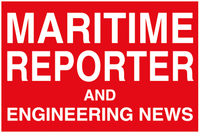
Page 33: of Maritime Reporter Magazine (June 2025)
Read this page in Pdf, Flash or Html5 edition of June 2025 Maritime Reporter Magazine
ELECTRIFICATION “Too often, we see owners fall in love with a design before they know how they’ll fund it. That’s backward.
Start with the budget.
Then design for what’s feasible now — and adaptable for the future.”
Watch the full interview with
Ed Schwarz @ – Ed Schwarz, Head of Marine
Solutions Sales for Siemens Energy in the US and Canada port vessels to containerships and defense applications, vir- map,” Schwarz says. “It shows how you can start with hybrid, tually every segment of the commercial maritime industry is validate the technology, and then move toward zero emissions exploring hybrid and electric options.” as infrastructure and budgets allow.”
What once felt like the future is increasingly the present. The takeaways are clear: emissions have dropped dramati-
Hybrid systems, which combine traditional diesel engines cally, operational costs have declined, and perhaps most im- with electric motors and battery storage, are now common portantly, the vessel’s owner says they would do it all over across a range of vessels. Even larger oceangoing ships— again. “That’s the litmus test,” says Schwarz. “Would you do historically considered too energy-intensive—are integrat- it again? In Ampere’s case — and in many others we’ve sup- ing power take-in (PTI) and power take-off (PTO) systems, ported — the answer is a con? dent yes.” making space for energy storage solutions and incremental decarbonization. Bene? ts with a Business Case “We used to feel like we had to convince the industry of the Owners who’ve made the leap to hybrid or electric consis- bene? ts,” says Schwarz. “Now, it feels like we’re being pulled in. tently report positive operational outcomes. Among them:
Operators want solutions—they’re asking the right questions.” ¦Emissions Reduction: Hybrid and fully electric systems can signi? cantly lower greenhouse gas and particulate
Ampere: A Case Study in Progress emissions, particularly in port and coastal environments.
Ampere, a Norwegian ferry that began as a hybrid and ¦Fuel Savings: Depending on the vessel type and evolved into a fully electric vessel, stands as a landmark proj- operational pro? le, fuel savings can range from 5% ect in this transition. Delivered nearly 10 years ago — with to over 50%.
development starting years before — Ampere was built at a ¦Reduced Maintenance: Electric motors and battery time when charging infrastructure was limited and fully elec- systems often require less maintenance than traditional tric propulsion was still a high-risk venture. mechanical systems.
Initially operating as a hybrid, Ampere leveraged diesel ¦Enhanced Reliability: Battery-assisted propulsion generators alongside battery power. Over time, as shoreside adds redundancy and can reduce downtime during charging capabilities were added and battery systems im- engine maintenance.
proved, the vessel transitioned to a fully electric operation.
“Ampere is more than just a technical success — it’s a road- Yet perhaps the most telling sign of success is repeat busi- www.marinelink.com 33
MR #6 (18-33).indd 33 MR #6 (18-33).indd 33 5/31/2025 8:15:40 PM5/31/2025 8:15:40 PM

 32
32

 34
34
